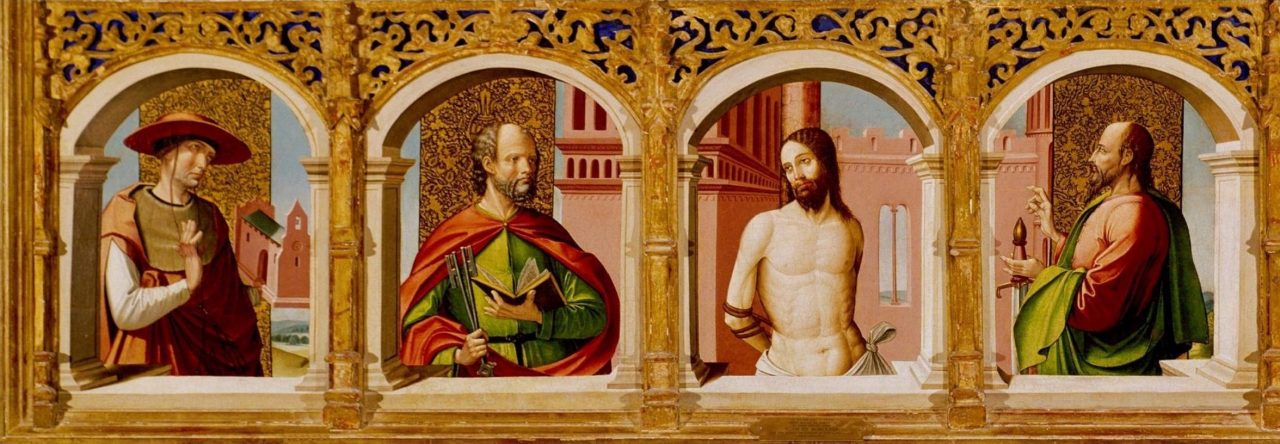Part 1 – Fezzan, Bunyoro and the pre-Vilatte era
 The institutions of prince-(arch)bishop and prince-abbot were at one point prominent within the Catholic Church. In each case, the princely status referred to a limited sovereign territorial governance, often confined to a tiny feudal territory surrounding the seat of the prelate, although the Emperors of Austria latterly bestowed the title as a form of political status without associated land. Although the prince-bishop has almost died out in our own time, there are still isolated survivals such as the Bishop of Urgell, who is co-Prince of Andorra.
The institutions of prince-(arch)bishop and prince-abbot were at one point prominent within the Catholic Church. In each case, the princely status referred to a limited sovereign territorial governance, often confined to a tiny feudal territory surrounding the seat of the prelate, although the Emperors of Austria latterly bestowed the title as a form of political status without associated land. Although the prince-bishop has almost died out in our own time, there are still isolated survivals such as the Bishop of Urgell, who is co-Prince of Andorra.
During the late nineteenth-century, the country now known as Libya was divided into separate regions, of which the Fezzan (Fizzan) occupied the south-west. The country is mainly desert with mountainous regions and oases which enable sparsely-populated settlements to survive. The nomadic Touareg people, who are Muslims, are found in the southern part of the territory, and the Touareg-Azgar inhabit the area around Ghat and Ghadames.
 From the 1880s, France took an increasing interest in Fezzan, seeking to colonize the region to connect its other possessions Tunisia, Morocco and Algeria. Although the Ottomans continued to exercise control over other parts of Libya, Fezzan proved impossible to subject because of the harsh nature of the terrain and its lack of a stable population.
From the 1880s, France took an increasing interest in Fezzan, seeking to colonize the region to connect its other possessions Tunisia, Morocco and Algeria. Although the Ottomans continued to exercise control over other parts of Libya, Fezzan proved impossible to subject because of the harsh nature of the terrain and its lack of a stable population.
In this atmosphere, a group of French and Spanish Roman Catholic Benedictine monks went to the Fezzan in 1883 to establish an abbey at the oasis settlement of Ghadames in the Touareg-Azzar country (Ghadames is shown to the extreme left on the 1906 map above). Today, this region is on the borderland between modern Libya, Tunisia and Algeria. On St Louis’ day, 25 August 1883, the Abbey-Principality of San Luigi was established, with the Spaniard Revd. Fr. Dom Henrice Pacomez elected the first Prince-Abbot. The Abbey-Principality was held to be a re-foundation of an ancient Templar body originally established by St Louis IX of France in the thirteenth-century. The independence of the Abbey-Principality was established by its Constitution, and it exercised sovereignty over the Abbey and its surrounding territory as a Catholic theocracy. On 15 October 1883, Prince-Abbot Henrice founded the Order of the Crown of Thorns and the Order of the Lion and the Black Cross.
 Conditions were not auspicious at the abbey. Disease was endemic in the unrelenting heat and the monks’ attempts to convert the local Muslim population to Catholicism were not welcomed. On 10 February 1884, Prince-Abbot Henrice died. Matters came to a head on 2 August 1884, when the local populace sacked the Abbey and murdered his successor as Prince-Abbot, Dom José Piantini (Joseph I). This action forced the new Prince-Abbot, Dom José Mendoza (Joseph II), and the remaining monks into exile.
Conditions were not auspicious at the abbey. Disease was endemic in the unrelenting heat and the monks’ attempts to convert the local Muslim population to Catholicism were not welcomed. On 10 February 1884, Prince-Abbot Henrice died. Matters came to a head on 2 August 1884, when the local populace sacked the Abbey and murdered his successor as Prince-Abbot, Dom José Piantini (Joseph I). This action forced the new Prince-Abbot, Dom José Mendoza (Joseph II), and the remaining monks into exile.
 Travelling south-east across the Sudanese swamplands (then part of Egypt), Prince-Abbot Joseph II and the four remaining brothers (Dom Severo Arrighi, Dom Luis Ferratera, Dom Antonio Voluppi and Dom Marco Asvedo) arrived in the Kingdom of Bunyoro-Kitara on 15 March 1885. Christian missionaries had previously been courteously received by the Omukama (King) Chwa II Kabalega (pictured), who ruled his people as an absolute monarch, and the monks received a warm welcome. In an act of great generosity, H.M. the Omukama granted territory to the monks in Bunyoro-Kitara to re-establish their Abbey, and additionally conferred upon the Prince-Abbot the chiefly title of Mukungu (translated as Prince-Governor, also incorrectly transcribed as Makougos) of the Chieftainship of the Ancient Abbey-Principality of San Luigi (Fizzan).
Travelling south-east across the Sudanese swamplands (then part of Egypt), Prince-Abbot Joseph II and the four remaining brothers (Dom Severo Arrighi, Dom Luis Ferratera, Dom Antonio Voluppi and Dom Marco Asvedo) arrived in the Kingdom of Bunyoro-Kitara on 15 March 1885. Christian missionaries had previously been courteously received by the Omukama (King) Chwa II Kabalega (pictured), who ruled his people as an absolute monarch, and the monks received a warm welcome. In an act of great generosity, H.M. the Omukama granted territory to the monks in Bunyoro-Kitara to re-establish their Abbey, and additionally conferred upon the Prince-Abbot the chiefly title of Mukungu (translated as Prince-Governor, also incorrectly transcribed as Makougos) of the Chieftainship of the Ancient Abbey-Principality of San Luigi (Fizzan).
 In 1888, an epidemic of tropical fever claimed the lives of all the monks save Prince-Abbot Joseph II. Accordingly, he made the decision to close the Abbey in Bunyoro and to return to Europe.
In 1888, an epidemic of tropical fever claimed the lives of all the monks save Prince-Abbot Joseph II. Accordingly, he made the decision to close the Abbey in Bunyoro and to return to Europe.
The background to Omukama Kabalega’s foreign relations and eventual demise can be explained thus. Bey Emin Pasha, governor of Equatoria in succession to General Charles Gordon (Gordon Pasha) from 1878, had formed a good working relationship with the Omukama during his diplomatic mission to Bunyoro in 1876 (not least because he spoke Luganda fluently). However, in the aftermath of the 1884 Mahdi revolt and the fall of Khartoum the following year, Emin Pasha and his men were driven back to Dufile on Lake Albert, where they awaited Sir Henry Morton Stanley’s relief expedition. By the time Emin Pasha and Stanley finally left in April 1889, friendly relations between the Omukama and the Europeans were at an end, and the Omukama began a series of raids into Buganda and Toro. Eventually the Omukama would engage in war against the British under the belligerent Captain Frederick Lugard, who was determined to conquer Bunyoro, and in 1899 the Omukama was defeated and exiled to the Seychelles, never to see his homeland again. His forcible deposition marked a loss of contact between San Luigi and Bunyoro that would last for over a century.
Now in France, and with the hope that one day the Abbey would be restored, Prince-Abbot Joseph II appointed the young Frenchman Louis-François de Girardot (1869-1959) his successor on St Louis’ Day 1896, resigning in his favour on 5 May 1897 with the appointment legalized before the Mayor of the Commune of Seine-Port (Île-de-France), M. Eugène Clairet (who served as mayor from May 1896 to May 1900) and two witnesses. This legalization by a French government official established the recognition of the Abbey-Principality by the French state.


You must be logged in to post a comment.